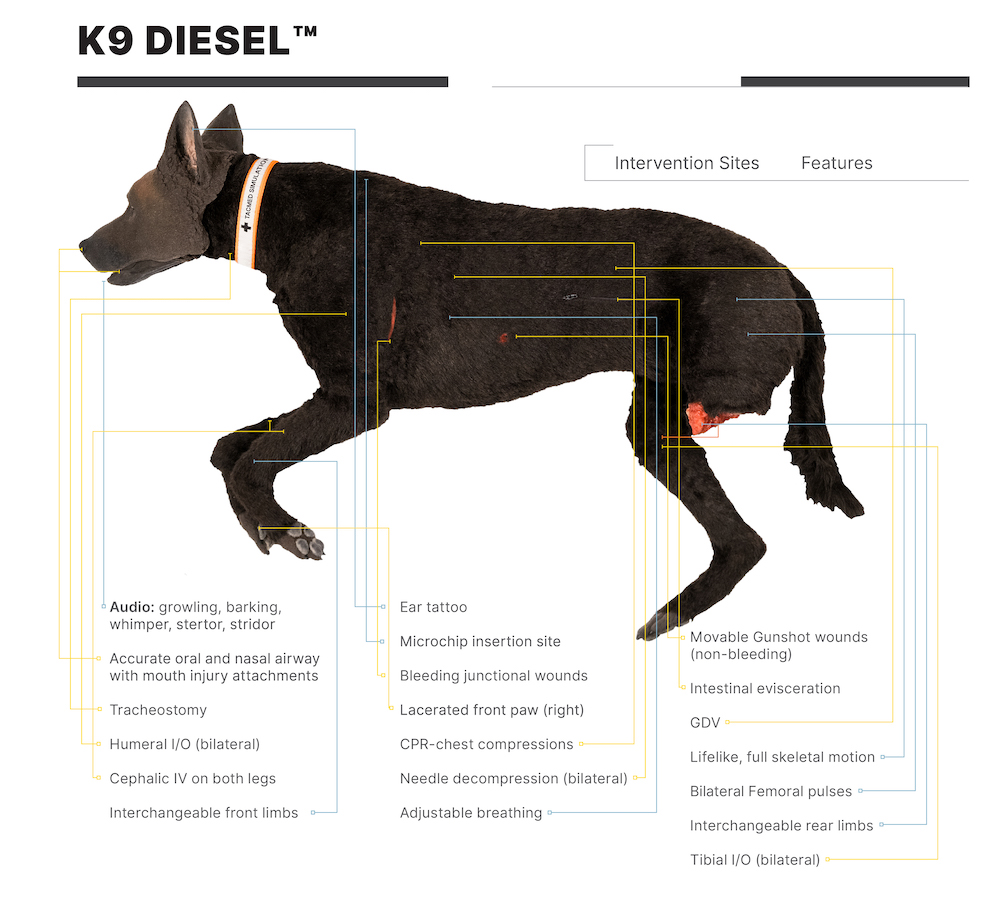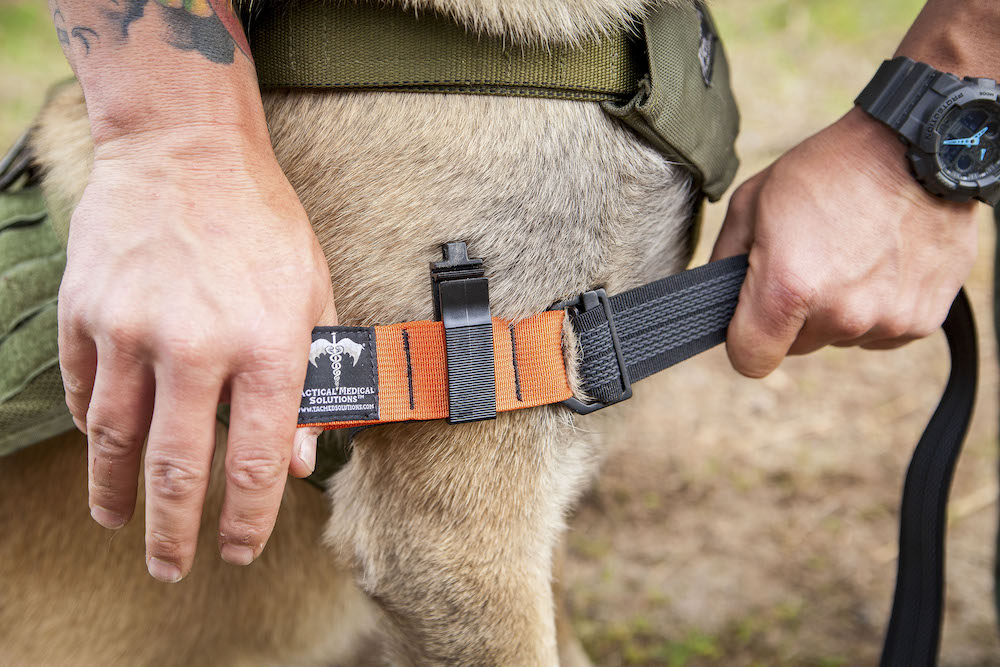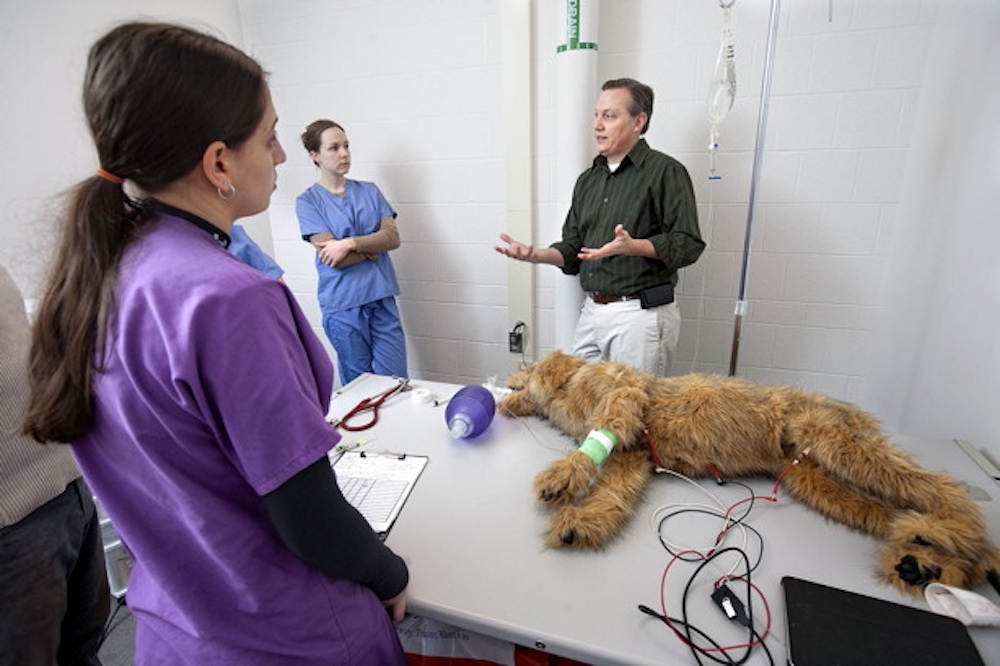Working dogs serve critical roles in many civilian and military organizations world-wide. The United States Government Accounting Office found, as of February 2022, about 5,500 working dogs served the federal government in some capacity in support of military operations, explosive and narcotic detection and other duties assigned. K9 Police officers are commonplace in today’s law enforcement landscape. However, only recently have efforts been made to address emergency care requirements for these important officers. Tactical Medical Solutions (aka TacMed Solutions or TMS) has been at the forefront of training and preparing K9 Handlers and others for emergency response to K9 trauma since the release of its first K9 Hero in 2016. Many simulation centers have a growing need to support stakeholders training in canine emergency medical care. Today, we review available resources for starting or improving simulation based K9 response training by looking at three important components: Curriculum, Simulation, and Canine medical supplies.
The first step in curriculum design is understanding learner needs. Edwards et al. published a comparison of trauma sustained by civilian and military working dogs. In a retrospective descriptive analysis of 193 cases in military working dogs (MWD), 26,099 cases of civilian dogs (CD) and 35 cases of Operational K9s (OpK9s), all three groups showed similar trends regarding type of trauma: penetrating injuries occurred most frequently followed by blunt injuries for CDs and OpK9s. K9 Trauma curriculum should be designed to systematically evaluate and treat these types of injuries. A great resource for K9 trauma training is the Deployed Medicine Canine-K9 Combat Casualty Care Website. This site provides detailed algorithms and training materials and is updated regularly by tactical veterinary medicine experts. Curriculums can be streamlined by focusing on the M3ARCH2 PAWS algorithm. Available in several sources, the Department of Homeland Security Working Dog Handler Medical Care Manual, another great downloadable resource, defines M3ARCH2 as:
- Move to safe cover
- Muzzle the canine for safety
- Control Massive bleeding
- Ensure an open Airway
- Treat Respiratory distress
- Treat Circulatory failure
- Treat or prevent Hypothermia
- Manage Head injury
PAWS represents care provided after Life Threatening injuries are addressed (Pain, Antibiotics, Wounds, Splinting). Making M3ARCH2 PAWS the centerpiece of your curriculum ensures the most critical components of K9 trauma response are addressed. If you are unfamiliar with K9 treatment, TacMed University offers a free 8 Module online course taught by world renown veterinarian, executive director and founder of K9 MEDIC, Jo-Anne Brenner, a leader and innovator in K9 trauma response. K9 MEDIC and VetBloom offer an affordable, innovative virtual training experience, the K9 Tactical Emergency Medical Simulator, that is great for distributive cognitive foundational knowledge building to pretrain for and optimize live training.
Because K9 casualties are rare in EMS and K9s are not good standardized patients, K9 emergency medical training is particularly amenable to simulation. Named after MWDs who died in the line of duty, TacMed created the K9 Hero and then K9 Diesel to meet this training gap.

K9 Diesel, the more complex of the two simulators, has 28 features designed to support K9 emergency medical training and is especially suited to M3ARCH2 PAWS training. These include:
- Lifelike, full anatomical skeletal motion
- Realistic airway with adjustable breathing – from slow (10 bpm) to panting (120 bpm)
- Intubation with chest rise and fall (stomach rise and fall if incorrectly placed in esophagus)
- Interchangeable front and rear limbs: include front legs with adjustable carpal fractures, two uninjured rear legs, and an amputated left rear leg with pressure-responsive bleeding
- Audio queues including barking, whimpering, growling, stertor, and stridor
- Cephalic IV training (bilateral) with flash cue
- Needle decompression/thoracocentesis with air release (bilateral)
- Femoral pulses (bilateral), strength and speed adjustable via remote control (60-170 bpm)
- Reusable lacerated paw for suture and bandage training
- Gastric Dilatation Volvulus decompression (GDV) site (bloat)
- CPR chest compressions with resistance
- Mouth-to-snout resuscitation
- Infusible (bilateral) Tibial and Humeral intraosseous (I/O) training with reusable bone plugs
- Intestinal evisceration
- Packable bleeding junctional wounds (bilateral)
- Moveable, simulated GSWs for chest seal training
- Tracheostomy training site with multi-layered tissue
- Realistic look and feel with a weight of ~60 lbs.
- Hydrophobic fur with washable leg socks
- Easy care and maintenance
- Optional limbs include lower amputation on front leg (left) and resettable compound fracture rear leg (right)
- Optional mouth wound kit includes injured mouth with throat blockage and tongue with injury
- Optional floppy ears
- Wireless remote control with real-time sensor data and programmable/customizable scenario
Tactical Medical Solution’s trademark simulator ruggedness, realism, simple operation, and mobility is built into K9 Diesel to support the most realistic training possible in the field. Armed with strong content and realistic simulation, all that is required for executing high quality training is the right medical supplies.
Some medical supplies and equipment can be used on humans and K9s interchangeably, but not all. The TacMed K9 Handler Trauma Kit provides the K9 Team with the necessary components to treat life-threatening injuries for law enforcement or military applications. Dual purpose items can be used to treat injuries to both the handler and K9. In addition, the K9 first aid kit contains specific items intended solely for the treatment of an injured working dog such as a K9 tourniquet, muzzle, endotracheal tube and 14GA decompression needles to address torsion and GDV. Because slippage is a common occurrence when tourniquets or pressure dressings designed for humans are used on canine casualties, TMS engineered the K9 Tourniquet to work effectively on tapered anatomy when placed high on the K9 limb. Integrated traction technology prevents the dog tourniquet from slipping down the animal’s leg which reduces tourniquet effectiveness.
Recently, Florida and several other states have passed laws allowing EMS personnel to treat and transport K9 casualties if there are no human patients. Many EMS organizations are unprepared for this. Forward thinking simulation centers and EMS training programs have a unique opportunity to meet this training need. The triad of quality content, realistic simulation and the right equipment will help students “elevate their response” to K9 trauma. TacMed Solutions is here to help.
Learn More About K9 Trauma Simulators from TacMed Solutions!
References:
- United States Government Accountability Office. Working Dogs: Federal Agencies Need to Better Address Health and Welfare Report to Congressional Committees October 2022 GAO-23-104489 U
- Thomas H Edwards 1, Laura L F Scott 1, Kerry E Gonyeau 2, Emily H Howard 3, Jacquelyn S Parker 4, Kelly Hall 5 . “Comparison of trauma sustained by civilian dogs and deployed military working dogs”. J Vet Emerg Crit Care (San Antonio) 2021 Jul;31(4):498-507. doi: 10.1111/vec.13064. Epub 2021 May 20.




